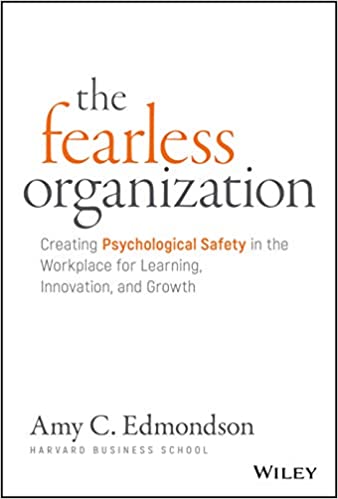
The Fearless Organization: Creating Psychological Safety in the Workplace for Learning, Innovation, and Growth - by Amy C. Edmondson
Date read: 2021-02-14How strongly I recommend it: 5/10
(See my list of 150+ books, for more.)
Go to the Amazon page for details and reviews.
A very important topic but poorly written. This could easily have been a 3,000 word article and you would have learned just as much from reading the entire book. Extremely redundant and the examples used were too well-known to be of any importance. The author also does not do a good job at all of explaining how to create psychological safety.
My Notes
I have defined psychological safety as the belief that the work environment is safe for interpersonal risk taking. The concept refers to the experience of feeling able to speak up with relevant ideas, questions, or concerns. Psychological safety is present when colleagues trust and respect each other and feel able – even obligated – to be candid.
A key insight from this work was that psychological safety is not a personality difference but rather a feature of the workplace that leaders can and must help create.
Psychological safety is about candor, about making it possible for productive disagreement and free exchange of ideas.
Trust is about giving others the benefit of the doubt, and psychological safety relates to whether others will give you the benefit of the doubt when, for instance, you have asked for help or admitted a mistake.
The two most frequently mentioned reasons for remaining silent were one, fear of being viewed or labeled negatively, and two, fear of damaging work relationships.
If your workplace is psychologically safe, you're more able to speak up even when you have less confidence.
The more we talk to each other, the more comfortable we become doing so.
Leaders who welcome only good news create fear that blocks them from hearing the truth.
Early information about shortcomings can nearly always mitigate the size and impact of future, large-scale failure.
Culture of silence can thus be understood as a culture in which the prevailing winds favor going along rather than offering one's concerns. It is based on the assumption that most people's voices do not offer value and thus will not be valued.
Psychological safety does not imply excessive talking and over-processing.
Psychological safety must be paired with discipline to achieve optimal results efficiently.
Instead of asking workers to give their opinions directly about safety issues, they asked, “what do we need to do to create a work environment of care and respect?” That was when workers started to feel safe enough to speak up about specific concerns.
Interestingly, she did not ask, “did you see lots of mistakes or harm?” Rather, she invited people to think in aspirational terms: “Was everything as safe as you would like it to be?” Sure enough, psychological safety started to take hold. People began to bring up incidents that they had seen and even contributed to.
OpenTable CEO Christa Quarles tells employees, “early, often, ugly. It's O.K. It doesn't have to be perfect because then I can course-correct much, much faster.”11 This too is a framing statement. It says that success in the online restaurant-reservation business occurs through course correction – not through magically getting it right the first time.
The leaders' tool kit contains a few rules of thumb for asking a good question: one, you don't know the answer; two, you ask questions that do not limit response options to Yes or No, and three, you phrase the question in a way that helps others share their thinking in a focused way.
I frequently ask managers, scientists, salespeople, and technologists around the world the following question: What percent of the failures in your organizations should be considered blameworthy? Their answers are usually in single digits – perhaps 1% to 4%. I then ask what percent are treated as blameworthy. Now, they say (after a pause or a laugh) 70% to 90%!
What can I do to help? What are you up against? What are your concerns?